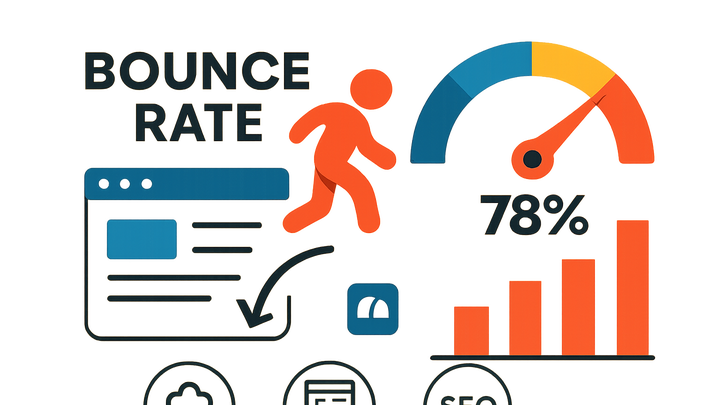Published on 2025-06-29T19:13:58Z
What is Bounce Rate? How It Affects CRO, UX & SEO
Bounce Rate measures the percentage of visitors who land on a web page and leave without interacting further. It’s a vital metric in conversion rate optimization (CRO), user experience (UX), and search engine optimization (SEO) because it signals how effectively your pages engage and retain visitors. A high bounce rate often points to slow load times, confusing navigation, or mismatched content, while a low rate suggests visitors are exploring deeper. However, context matters: single-page interactions like blog posts may naturally have higher bounce rates. Tools such as Google Analytics and Prevue.me provide actionable critiques—covering CRO, lead generation, SEO, UX, and accessibility—to diagnose and reduce bounce rates for maximum impact.
Bounce rate
Metric showing the percentage of single-page sessions, signaling how well pages engage and retain visitors.
Understanding Bounce Rate
This section explains what bounce rate means in web analytics, when a “bounce” occurs, and common scenarios where bounce rate provides insights.
-
Definition
Bounce rate is the proportion of sessions where users view only one page and take no further action before leaving.
-
Calculation
Calculated as
(single-page sessions ÷ total sessions) × 100; for example, 80 single-page sessions out of 200 total sessions yields a 40% bounce rate.
Why Bounce Rate Matters
Bounce rate is a critical indicator across CRO, UX, and SEO, helping teams identify engagement issues, improve site performance, and optimize content relevance.
-
Cro impact
A high bounce rate often means potential leads exit before converting; reducing bounces can directly boost lead generation and revenue.
-
Ux insights
Bounce rate reflects user satisfaction; frequent bounces may signal confusing navigation, poor readability, or slow load times.
-
Seo signals
Search engines may interpret high bounce rates as signs of low relevance, which can influence rankings—though bounce rate is just one of many SEO factors.
Measuring Bounce Rate
Discover tools and methods to accurately track and analyze bounce rate for informed decision-making.
-
Google analytics
The most widely used tool; provides bounce rate metrics by page, traffic source, device, and more, with customizable reports.
-
Prevue.me diagnostics
prevue.me offers automated critiques pinpointing UX, accessibility, and content issues that correlate with high bounce rates.
-
Other analytics platforms
Platforms like Adobe Analytics, Matomo, and Mixpanel also track bounce metrics, each offering unique segmentation and visualization features.
Strategies to Reduce Bounce Rate
Practical approaches to engage visitors, encourage interaction, and lower bounce rates across various page types.
-
Improve page load speed
Optimize images, enable browser caching, and minimize JavaScript to ensure pages load within 2–3 seconds, reducing bounce probability.
-
Optimize content relevance
Use clear headlines, relevant keywords, and engaging media to match visitor intent and encourage deeper exploration.
-
Enhance navigation and ux
Implement intuitive menus, breadcrumbs, and interactive elements to guide users to related content and calls-to-action.
-
Use clear ctas
Design prominent, action-oriented buttons with compelling copy to prompt clicks, form submissions, or other desired actions.
Example: Using Prevue.me to Audit Bounce Rate
See how prevue.me can be used to identify high-bounce pages, understand root causes, and get prioritized recommendations for improvement.
-
Site crawl report
prevue.me scans your site and lists pages with the highest bounce rates alongside actionable UX, SEO, and accessibility critiques.
-
Audience behavior analysis
Leverage heatmaps and session recordings to visualize where users drop off and what content fails to engage.
-
Actionable recommendations
Receive prioritized action items—like optimizing headings, adjusting layout, and improving load times—to systematically reduce bounce rates.
